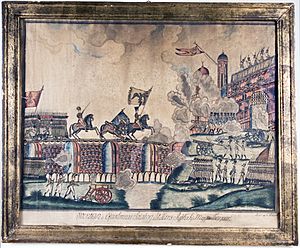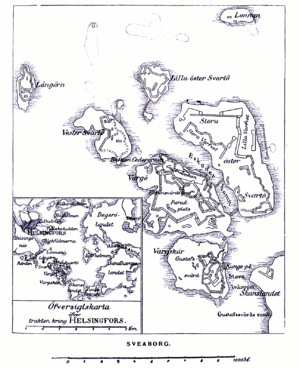Siege of Sveaborg facts for kids
Quick facts for kids Siege of Sveaborg |
|||||||
|---|---|---|---|---|---|---|---|
| Part of the Finnish War | |||||||
 Sveaborg surrenders to the Russians |
|||||||
|
|||||||
| Belligerents | |||||||
| Commanders and leaders | |||||||
| Strength | |||||||
| 7,503+ | 6,500 | ||||||
| Casualties and losses | |||||||
| Whole garrison captured, 58 guns lost |
Unknown | ||||||
The Siege of Sveaborg was a major event during the Finnish War in 1808. It was a siege where Russian forces surrounded and attacked the strong sea fort of Sveaborg. This fort, also known as Suomenlinna, was located off the coast of Helsingfors (now Helsinki) in Finland. At that time, Finland was part of the Kingdom of Sweden.
The siege happened in the spring of 1808. Sveaborg was famous for being a very strong fortress, sometimes called "the Gibraltar of the North." However, it surrendered to the Russians after being surrounded for two months. This surrender was a huge turning point. It led to the quick defeat of Swedish forces and Russia taking control of Finland. Because of this, the Siege of Sveaborg is often seen as the most important battle of the war.
Contents
Preparing for the Siege
About a week before the war started, Admiral Carl Olof Cronstedt was in charge of Sveaborg. He received a letter from the Swedish King, Gustav IV Adolf. The King ordered him to get two special ships, called hemmema-type frigates, ready for battle. He also needed to prepare over 70 smaller gunboats.
The King's letter also said that Sveaborg had to be defended no matter what. If the fort had to be given up, all the ships docked there for winter and all the supplies had to be burned. This was to prevent them from falling into enemy hands.
The Siege Begins
Russian forces, led by Friedrich Wilhelm von Buxhoeveden, started to surround Sveaborg. This happened after they captured Helsingfors on March 2, 1808. At first, the Russian force was small, only about 2,000 men. They weren't strong enough to seriously attack the huge fortress.
By mid-March, the Russians had gathered more troops. General Jan Pieter van Suchtelen arrived with about 4,000 men. They began a more serious siege. They set up artillery batteries, which are places where cannons are positioned to fire at a target. By early April, the Russians had 6,500 men and 59 cannons. Some of these cannons were taken from the Svartholm fortress after it surrendered.
The Swedish defenders at Sveaborg often shot at Russian patrols on the ice around the fort. However, these shots didn't do much damage. Instead of attacking the smaller Russian force, the Swedes stayed inside their strong walls. They prepared for a Russian attack by cutting a ditch in the ice around the fortress. This would make it harder for the Russians to cross.
The first Russian cannon fire, called barrages, started on March 19. They continued until March 21. After this, both sides tried to talk things over. Admiral Cronstedt agreed not to fire at the town of Helsingfors. In return, the Russians agreed to keep their cannons away from the town. This was good for the Russians because it meant their soldiers could stay in Helsingfors safely.
On March 23, Cronstedt met with Russian representatives on an island called Lonnan. The Russians demanded that the fortress surrender. The Swedes refused. So, the Russians started firing their cannons again on March 25. This lasted until April 1. The Russians repeated their demand for surrender on April 2.
The Russians also used clever tactics to convince the Swedish officers to give up. They allowed officers' wives, who lived in Helsingfors, to visit their husbands in Sveaborg. These visits helped to spread the idea of surrendering. A trusted advisor to Cronstedt, Colonel Fredrik Adolf Jägerhorn, also played a key role in these efforts.
Surrender of Sveaborg
During the talks on April 2, Cronstedt suggested a truce until May 13, 1808. A truce is a temporary stop to fighting. The Russians agreed but wanted the truce to end on May 3. They also demanded to take control of several small, fortified islands around Sveaborg during this time.
Cronstedt discussed the situation with his officers. He believed the fortress only had enough ammunition for two more weeks. Many men were also getting sick. When asked about burning the fleet, Cronstedt refused. He said it would be a disaster if the fortress survived but had no ships left.
On April 6, Cronstedt made an agreement with Jan Pieter van Suchtelen, the Russian commander. They agreed to an honorable surrender on May 3. This would happen if Swedish reinforcements did not reach Sveaborg by that date.
However, the Swedish messengers carrying requests for help were delayed by the Russians. They didn't reach Stockholm until May 3. This was the very day Cronstedt surrendered the fortress to the Russians. Along with the fort, 7,500 soldiers and a fleet of 94 ships were captured. Even if the messengers had arrived earlier, it would have been hard to send help. The winter was very cold, and the Baltic Sea was still partly frozen. During the siege, Sveaborg lost 6 men killed and 32 wounded. A few roofs and windows were also damaged.
What Happened Next
Taking Sveaborg was a huge win for the Russian army in Finland. It meant they no longer had to worry about an attack from the south or west. For Sweden, it was a terrible loss. It made it much harder to send supplies to their army in Finland.
The Russians captured most of the Swedish archipelago fleet. This included many different types of ships, like 3 hemmema and 7 turuma frigates, 25 gun sloops, and 51 gun yawls. This greatly changed the war in the Finnish archipelago. The Russian battle fleet was not strong enough to fight the combined Swedish and British fleets in the open sea. But now they had many more ships for coastal battles.
However, an explosion happened at Sveaborg on June 3, 1808. A fire broke out afterwards. This caused a lot of damage to the captured ships. For example, six of the seven captured turuma frigates were destroyed.
The Russians continued to win battles against the Swedes throughout the summer. By autumn, they had taken over all of Finland. In the spring of 1809, they also conquered the Åland Islands. They even threatened Stockholm, the capital of Sweden. Because of this, Sweden was forced to sign the Treaty of Fredrikshamn. This treaty gave both Finland and Åland to the Russian Empire.
Since Sveaborg was seen as the strongest fort in Finland, its quick surrender led to many questions. People suspected Admiral Cronstedt of being a coward or even a traitor. He was blamed for Sweden's defeat. Cronstedt wisely stayed in Finland after being released by the Russians. But he was still put on trial for treason in Sweden. He was found guilty even though he wasn't there. This was ironic because Cronstedt had been a hero before the war. He had won a great victory against the Russian navy in the Second Battle of Svensksund during an earlier war.
Sveaborg in Stories
The Finnish-Swedish poet Johan Ludvig Runeberg wrote a poem called Sveaborg. It is one of 35 short poems in his famous work, The Tales of Ensign Stål. This epic story is about the Finnish War and was published between 1848 and 1860. The poems are very nationalist in tone. They clearly blame Cronstedt for the Swedish defeat in the war. The last three parts of Sveaborg even call for his name to be forgotten.
Hide away his family, do not mention his tribe,
Do not turn away from his crime.
Let no one blush on account of his shame,
It sticks to him alone.
He, who has betrayed his land, has
No family, no tribe, no son, no father.
Name him only as the false arm
Sent to Finland's aid.
Name him "Shame" and "Scorn" and "Disgust",
And "Guilt" and "Punishment" and "Death".
It is merely what he deserves to be called,
It is to spare the listener.
Take all that is dark in the grave,
And all that is torment in life,
And form a name from it,
And give it to him.
However, even this would arouse less sorrow,
Than that which he brought upon Sveaborg.
A short story called "Under Siege" by George R. R. Martin also takes place during the Siege of Sveaborg. It was published in Omni magazine in October 1985. This story is a new version of an earlier story called "The Fortress," which Martin wrote for a college history paper. Both "The Fortress" and "Under Siege" are included in Martin's collection of short stories called Dreamsongs. In "Under Siege," time travelers from a difficult future affect what happens during the siege.


